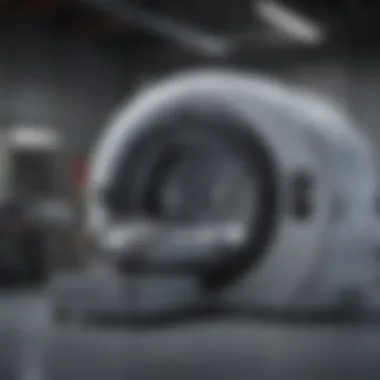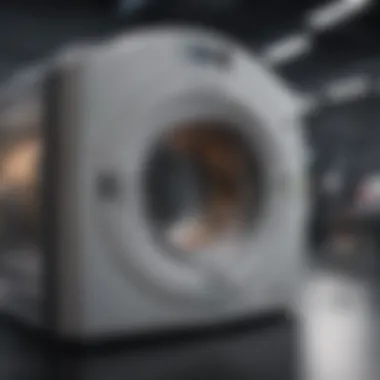Exploring the 512 Slice CT Scanner: Innovations and Applications


Summary of Objectives
The evolution of computed tomography (CT) technology has yielded pivotal advancements in medical imaging. This article focuses on the 512 slice CT scanner, delving into its design, operational principles, and the distinct advantages it holds over previous generations. By offering high-resolution images in rapid succession, this technology promises to enhance diagnostic capabilities across various medical disciplines.
Importance of the Research
Understanding the innovations encapsulated in the 512 slice CT scanner is crucial for professionals in health sciences and engineering. This research aids in grasping how cutting-edge imaging technologies can refine patient care and implications for future research and development in the imaging field.
Intro
The development of imaging technology plays a vital role in modern medicine. Among these innovations, the 512 slice CT scanner stands out. It represents a significant leap in capturing detailed images quickly. Such advancements are not just mechanical or software updates; they fundamentally alter how radiologists and medical professionals diagnose and treat patients. The capacity of this device to take a multitude of slices in a single rotation offers unprecedented clarity and speed.
In this exploration, we will unravel the intricate aspects of the 512 slice CT scanner. From design elements to the engineering prowess that makes it possible, we aim to provide a cohesive narrative that showcases its significance in healthcare. Understanding the implications of this technology can enhance the dialogue among researchers, educators, and practitioners in diverse fields.
The 512 slice CT scanner utilizes sophisticated techniques to achieve high-resolution imaging. The innovations in image processing and the integration of advanced algorithms allow for enhanced detail and speed, marking a departure from earlier models. The ramifications for patient care and operational efficiency in healthcare facilities are profound and will be discussed in detail throughout this article.
Through this comprehensive overview, we hope to intrigue and inform our audience about the innovations and applications of the 512 slice CT scanner, providing a foundation for further exploration and discussion.
Prelude to CT Technology
The field of medical imaging has undergone remarkable transformations over the past few decades, with computed tomography (CT) emerging as a crucial tool for diagnosis and treatment planning. CT technology plays a significant role in providing detailed cross-sectional images of the body, allowing healthcare professionals to visualize internal structures non-invasively. This section explores the importance of CT technology, laying the groundwork for understanding the innovations brought about by the introduction of the 512 slice CT scanner.
The benefits of CT technology are extensive. Its ability to quickly produce high-resolution images has improved diagnostic capabilities. Clinicians can detect diseases at earlier stages, contributing to better treatment outcomes. Moreover, CT scans provide critical information for various medical scenarios, including surgeries, trauma assessments, and oncology evaluations.
Nevertheless, there are considerations that healthcare providers must keep in mind. Issues such as radiation exposure and accessibility to advanced imaging technologies vary across institutions and regions. These factors play a pivotal role in determining how effectively CT technology can be implemented to benefit patient care.
Historical Perspectives
Computed tomography was first conceptualized in the early 1970s by Sir Godfrey Hounsfield and Dr. Allan Cormack. Their pioneering work led to the development of the first commercially available CT scanner in 1971. This initial machine utilized a single slice design, which significantly improved image quality compared to traditional X-ray imaging. The technology evolved throughout the 1980s, moving from single slice to multi-slice systems, each iteration enhancing image clarity and speed of acquisition.
As the decades progressed, the introduction of new algorithms and computing capabilities enabled the use of helical scanning. This advancement further improved the efficiency and accuracy of CT images, setting the stage for more complex systems to emerge.
Development of Slice Technology
The introduction of the 512 slice CT scanner in the late 2000s marked a significant milestone in imaging technology. With an ability to acquire 512 slices in one rotation, these machines deliver exceptionally detailed images quickly. Each of these slices represents thin cross-sectional views of the body, enabling more intricate examinations of various anatomical structures.
This advancement is attributed to several technical innovations, including faster detector technology and advanced software for data processing. The development of multidetector array technology has permitted greater coverage and improved temporal resolution. As a result, 512 slice CT scanners allow for real-time imaging, making them indispensable in acute situations such as trauma or cardiovascular emergencies.
In summary, the evolution of CT technology from its initial stages to the cutting-edge innovations of the 512 slice scanner reflects a significant leap in medical imaging capabilities. Understanding these transformations is crucial for realizing the full potential of CT technology in enhancing patient care.
Understanding the Mechanics
Understanding the mechanics of the 512 slice CT scanner is critical in appreciating its role within modern medical imaging. This section aims to elucidate core components, image acquisition techniques, and data processing methods. The innovation in CT technology has fundamentally altered both diagnostic procedures and patient care processes. By exploring these mechanics, readers can gain insights into not just how these machines function, but also how they provide enhanced clinical outcomes.
Core Components of a CT Scanner
A 512 slice CT scanner consists of several essential components. Each component plays a unique role in achieving high-resolution imaging. Some core elements include:
- X-ray Tube: This component generates X-rays directed toward the patient. The tube rotates around the patient, capturing multiple angles during a single pass.
- Detectors: The detectors collect the X-rays that pass through the body. The 512 slice scanner typically employs advanced solid-state detectors, which allow for greater sensitivity and improved image quality compared to traditional models.
- Gantry: This is the structure that houses the X-ray tube and detectors. It rotates around the patient and ensures accurate alignment for optimal imaging.
- Computer System: Responsible for data acquisition and processing, the computer system converts raw data into usable images. This system must handle large volumes of data efficiently due to the scanner's high slice count.
These components work in concert to produce detailed images of internal anatomy, making diagnosis more accurate and efficient.
Image Acquisition Process
The image acquisition process in a 512 slice CT scanner is notably distinct from older models. Traditional CT scanners utilized fewer slices and required longer scan times. In contrast, the 512 slice system captures multiple slices of data in mere seconds.


During the acquisition phase, the X-ray tube rotates around the patient, firing X-rays through the body. As the X-rays pass through various tissues, they are attenuated differently, based on tissue density. The detectors measure the intensity of the X-rays that emerge from the body. This process generates a voluminous amount of raw data that is later processed into images.
The speed of acquisition allows for significant applications, especially in emergency medicine, where timely imaging can be critical.
Data Processing Techniques
Data processing is a fundamental aspect of the 512 slice CT imaging workflow. After the X-ray data is collected, sophisticated algorithms are used to reconstruct the images. The use of iterative reconstruction methods has become more prevalent, decreasing image noise while enhancing resolution.
Key techniques include:
- Filtered Back Projection: This method involves filtering the projection data to obtain clearer images. It's effective but can introduce artifacts.
- Iterative Reconstruction: Employed to refine images progressively, this technique reduces radiation dose while improving clarity. It recalculates the image multiple times until optimal quality is achieved.
- Multi-planar Reconstruction (MPR): This allows images to be viewed in various planes. It's especially useful for assessing complex internal structures, such as blood vessels and organs.
Advantages of the Slice CT Scanner
The 512 slice CT scanner represents a significant leap in computed tomography, bringing several advantages that enhance diagnostic performance and patient care. The importance of understanding these advantages cannot be overstated. They not only contribute to improved image quality and faster diagnostics, but they also redefine safety standards in imaging practices.
The ability to efficiently capture images is crucial in modern medical settings. In this competitive and challenging environment, CT technology must deliver results swiftly without compromising accuracy. The enhanced features of the 512 slice CT scanner play a transformational role in achieving these goals. Below are the key advantages highlighted in this section.
Speed and Efficiency
The 512 slice CT scanner significantly reduces the time required for image acquisition. Traditional CT scanners often take longer to collect sufficient data for a diagnostic image. This can delay crucial treatments, especially for conditions requiring immediate attention, such as strokes or trauma. With the capability to capture up to 512 slices in one rotation, the 512 slice CT scanner allows for a faster scan time, often reducing the total imaging time to less than a minute.
Additionally, the scanner's efficiency allows healthcare facilities to handle higher patient volumes. This means patients experience shorter waiting times for scans, leading to quicker diagnoses and faster treatment initiation. The overall effect enhances the workflow in hospitals and clinics, making care more accessible.
Enhanced Image Quality
One of the most notable features of the 512 slice CT scanner is the superior image quality it produces. This advancement stems from improved technological components, such as enhanced detectors and refined algorithms. The high-slice capability leads to greater detail in imaging, revealing fine anatomical structures that are often missed in lower slice scanners.
Physicians benefit from these high-resolution images when diagnosing various conditions, particularly in complex cases like oncology and cardiovascular diseases. As a result, clinicians can make more informed decisions based on accurate representations of a patient's anatomy, leading to better tailored treatment plans.
"The precision offered by a 512 slice CT scanner potentially leads to improved patient outcomes and reduced healthcare costs over time."
Reduction in Radiation Exposure
Concerns about radiation exposure from diagnostic imaging remain a significant consideration in healthcare. The 512 slice CT scanner has addressed this issue through advanced imaging techniques and software optimization.
These scanners often employ adaptive dose reduction technologies that allow them to adjust radiation dose based on the specific patient's needs, without compromising image quality. This capability is particularly important for vulnerable populations like children, who are more sensitive to radiation.
Furthermore, lower radiation doses not only protect patients but also contribute to the ethical standards of medical practice. The advancement in technology allows clinicians to perform necessary scans while minimizing health risks associated with radiation exposure.
In summary, the advantages of the 512 slice CT scanner extend beyond mere technological improvements. They offer practical benefits that enhance patient care, improve diagnostic precision, and address critical safety concerns associated with radiation. As medical imaging technology evolves, it is clear that these innovations will play a pivotal role in shaping the future direction of healthcare.
Clinical Applications
The clinical applications of the 512 slice CT scanner are pivotal in modern diagnostics. This advanced technology has broadened the scope of imaging in various medical fields. Its ability to produce high-resolution images rapidly has profound implications for accurately diagnosing a range of conditions. Each application has specific benefits tailored to enhance patient outcomes and optimize treatment protocols.
Cardiovascular Imaging
Cardiovascular imaging significantly benefits from the capabilities of the 512 slice CT scanner. Cardiac diseases remain a leading cause of mortality worldwide. The precision of this imaging technology allows for detailed visualization of coronary arteries, enabling the identification of blockages and lesions. The scanner can deliver images of the heart's anatomy and function in seconds, which is crucial during emergencies.
Benefits include:
- Rapid Acquisition: This technology can capture images much more quickly than earlier models. Quick diagnostics facilitate timely interventions.
- High-Resolution Images: The 512 slice capability results in much clearer images than typical scans. This clarity can be vital for planning surgeries or other treatments.
In cases of chest pain or suspected heart attacks, the possibility of obtaining a correct assessment using a 512 slice CT scanner is invaluable. It serves as a non-invasive method to explore cardiac status.
Oncology and Tumor Assessment


In oncology, the 512 slice CT scanner plays a critical role in tumor detection and management. Detecting tumors at an early stage greatly improves treatment outcomes. The high-speed imaging capability offers significant advantages in tracking tumor growth or response to therapy.
Key points include:
- Early Detection: The enhanced image quality supports the identification of small tumors that might be missed by other imaging modalities.
- Guidance for Biopsies: The precision of 512 slice CT scans can guide interventional procedures such as biopsies. This reduces risk and increases accuracy in sampling tumor tissues.
Timely imaging can change the course of care for patients with cancer, highlighting the essential role of advanced imaging in oncology.
Trauma Imaging
In trauma situations, the speed and detail of 512 slice CT scans are invaluable. Rapid assessment can mean the difference between life and death. Emergency departments are seeing more use of this technology as it provides detailed information on internal injuries quickly.
The advantages here are:
- Comprehensive Assessment: The ability to capture images of various body parts in a single scan can help detect multiple injuries simultaneously.
- Reduced Time to Diagnosis: High-speed acquisition helps in promptly diagnosing critical issues such as internal bleeding or organ damage, allowing faster treatment initiation.
In trauma cases, this technology significantly aids in triaging patients and planning surgical interventions effectively.
Pediatric Applications
The application of 512 slice CT technology in pediatrics deserves special attention. The unique challenges inherent in scanning children require adaptations in technique and practice.
Considerations include:
- Reduced Radiation Exposure: Since children are more sensitive to radiation, lower dose techniques associated with 512 slice scanning are crucial. This means healthcare professionals can obtain necessary diagnostic information while minimizing risk.
- Non-Invasive Exploration: Pediatric patients often present analytic complexities. The capability to perform comprehensive scans non-invasively is essential for accurate diagnosis.
Overall, the integration of this advanced imaging technology in pediatrics offers improved care while addressing the specific needs of younger patients.
Impact on Patient Care
The intersection of 512 slice CT scanners and patient care is significant and transformative. This advancement in imaging technology does not only enhance the diagnostic landscape but also directly contributes to better patient outcomes. As healthcare systems evolve, the need for rapid and accurate diagnosis becomes paramount. The design and capabilities of the 512 slice CT scanner play a crucial role in addressing these challenges.
Streamlined Diagnosis
The application of 512 slice CT scanners facilitates streamlined diagnosis across various medical disciplines. These scanners allow for faster image acquisition, producing detailed and high-resolution images in a shorter time frame. This is particularly vital in emergency settings where every second counts. For instance, in cases of suspected stroke or trauma, a rapid CT scan can significantly alter the management approach and treatment pathway.
By rapidly producing clear images, clinicians can make more informed decisions without delay. The ability to visualize soft tissues, blood vessels, and organs in near real-time enhances diagnostic accuracy and confidence. Consequently, unnecessary tests or procedures may be avoided, promoting patient safety and optimizing resource utilization in healthcare facilities.
Moreover, automation in image processing adds to the speed of diagnosis. Advanced algorithms can almost instantly analyze scan results, leading to quicker interpretations by radiologists. This integration of technology with human expertise represents an evolution that benefits both patients and medical professionals.
Faster Treatment Decisions
In healthcare, the speed of treatment decision-making is as critical as the quality of the diagnosis. The 512 slice CT scanner's capability to provide immediate and detailed images ensures that treatment decisions can be expedited. In oncology, for example, rapid diagnosis of tumors through comprehensive imaging informs treatment plans swiftly. Whether it is surgery, radiation, or chemotherapy, having a clearer picture of the cancer's extent influences the urgency and nature of intervention.
Additionally, in critical care scenarios, fast treatment decisions can be life-saving. The prompt identification of conditions such as pulmonary embolism or aortic dissection allows for immediate intervention, substantially improving the patient’s prognosis.
The integration of real-time data sharing also enhances collaboration among healthcare providers. Specialists across disciplines can discuss findings and treatment plans using the same images, which promotes a more coordinated approach to patient care. This teamwork is essential in complex cases where multiple specialties are involved.
"The introduction of 512 slice CT technology has paved the way for enhanced efficiencies in patient care, providing a platform for quicker diagnostic processes and treatment paths."
Challenges and Considerations
The rapid advancement in medical imaging technology, particularly the development of the 512 slice CT scanner, comes with a host of challenges and considerations that must be addressed. These elements are vital for ensuring that the benefits of this technology are fully realized in clinical practice. Understanding these challenges can help stakeholders make informed decisions that affect both healthcare providers and patients.
Cost and Accessibility


The introduction of the 512 slice technology does not come without its financial implications. Accurately assessing the cost of purchasing, operating, and maintaining these advanced machines is crucial. Not all healthcare facilities may have the budget for such equipment, which can lead to disparities in access to this cutting-edge imaging technology.
- Initial Investment: The price tag for a 512 slice CT scanner is significant, often reaching into the millions of dollars. Smaller clinics and hospitals may struggle to justify such an expenditure.
- Operational Costs: Beyond the initial purchase price, ongoing expenses for maintenance and staffing trained professionals can pile up. These costs can lead to increased charges for patients.
- Insurance and Reimbursement Challenges: Insurers may not always cover advanced imaging technologies, which can leave patients with unexpected expenses.
Addressing these issues requires a collaborative effort from manufacturers, healthcare providers, and regulatory bodies to ensure equitable access to this life-saving technology.
Training Requirements
With the implementation of the 512 slice CT scanner, there is a pressing need for specialized training for medical personnel. Operating these advanced machines involves expertise that goes beyond traditional training for standard CT scanners.
- Radiologist Proficiency: Radiologists must gain familiarity with interpreting high-resolution images produced by this technology. This often requires additional training programs or certification.
- Technologist Skills: Technologists responsible for operating the scanner must also undergo comprehensive training. Understanding the nuances of this equipment is essential to optimize image quality and improve patient outcomes.
- Continuous Education: As technology evolves, ongoing education is necessary to keep all staff updated on the best practices for using the scanner and interpreting its results effectively.
Addressing training needs not only ensures better patient care but also mitigates potential risks associated with improperly conducted scans.
Patient Safety and Ethical Considerations
In the realm of medical imaging, patient safety remains a top priority. The use of advanced imaging tools such as the 512 slice CT scanner necessitates careful attention to ethical implications and safety protocols.
- Radiation Exposure: Although 512 slice scanners are designed to minimize radiation doses, the cumulative effect of multiple scans and the potential for higher radiation in certain procedures must be considered. Continuous assessment of exposure levels is critical to safeguarding patient health.
- Informed Consent: Patients must be fully informed about the implications of undergoing scans, including risks associated with radiation exposure. Transparency in the consent process is fundamental to ethical practice.
- Privacy and Data Security: With the increased sophistication in imaging technology, maintaining the confidentiality of patient data is paramount. Strong protocols need to be established to protect sensitive medical information.
"With rapid advancements in technology, continuous attention to patient safety and ethical considerations in medical imaging is essential to protect those who rely on these services."
Future of CT Imaging Technology
The advancements in computed tomography (CT) technology, particularly with the 512 slice CT scanner, have significant implications for the future of medical imaging. As the demands for faster, more detailed imaging continue to grow, it is vital to explore emerging technologies and integration possibilities with other modalities. Understanding these elements helps to grasp how CT technology can adapt and evolve, providing better solutions for patient care and diagnosis.
Emerging Technologies
New technologies keep reshaping the landscape of CT imaging. Innovations like photon-counting detectors are set to change how we acquire data. These detectors promise to improve image quality while reducing radiation exposure. Another promising development is artificial intelligence (AI). AI can enhance image processing and improve diagnostic accuracy by analyzing vast amounts of data quickly.
Other notable technologies include:
- Spectral CT: This technique captures images at different energy levels, allowing for better differentiation of tissues.
- High-Resolution Imaging: Continuous advances in hardware lead to the development of scanners that can achieve even greater resolution and clarity.
The implementation of these technologies can lead to not just better images, but also improved workflow efficiency and patient throughput.
Integration with Other Modalities
For CT imaging to progress effectively, it is essential to explore its integration with other diagnostic modalities. Combining CT technology with Magnetic Resonance Imaging (MRI) and Positron Emission Tomography (PET) can offer multifaceted insights into a patient’s condition.
Benefits of integration include:
- Comprehensive Analysis: By obtaining data from multiple sources, physicians can achieve a more accurate diagnosis.
- Reduced Need for Separate Procedures: Patients could benefit from a one-stop approach, where several imaging modalities are utilized in a single session.
- Enhanced Treatment Planning: Integrated imaging can allow for better surgical planning, especially in complex cases involving tumors or injury assessments.
As CT technology continues to advance, examining the interface between different imaging modalities will be crucial. This synergy could significantly enhance patient outcomes and streamline clinical workflows.
"The integration of CT with other imaging techniques offers a more robust diagnostic approach, enabling healthcare professionals to provide tailored patient care."
Closure
The conclusion of this article serves as an essential encapsulation of the innovations and applications associated with the 512 slice CT scanner. This technology represents a significant leap forward in the field of medical imaging, providing enhanced diagnostic capabilities that are crucial for healthcare professionals. The ability to acquire high-resolution images swiftly has transformed how clinicians assess and address patient needs, thereby influencing treatment pathways and improving outcomes.
Summary of Key Points
In summarizing the key points of this article, it is essential to highlight the following aspects:
- Technological Advancements: The 512 slice CT scanner utilizes advanced engineering to enhance image quality and acquisition speed.
- Clinical Applications: This technology has made notable contributions in various fields including cardiovascular imaging, oncology, trauma, and pediatrics.
- Patient Care Impact: The scanner's efficiency allows for streamlined diagnoses and faster treatment decisions, significantly benefiting patient care.
- Challenges: While the advantages are numerous, challenges such as cost, accessibility, and training requirements must be addressed to fully harness its potential.
Final Thoughts on Advancements
The advancement of 512 slice CT technology signals a pivotal moment in medical imaging. As healthcare continues to evolve, this technology can provide not only diagnostic precision but also greater efficiency. It is critical for professionals in the field to stay informed about these advancements to effectively integrate them into practice. The ongoing research and development in CT technology give promise for future innovations that can further enhance patient care.
In an ever-changing medical landscape, adapting to new technologies like the 512 slice CT scanner is integral for health professionals. This adaptation ensures improved diagnostic tools that lead to better health outcomes for patients.















